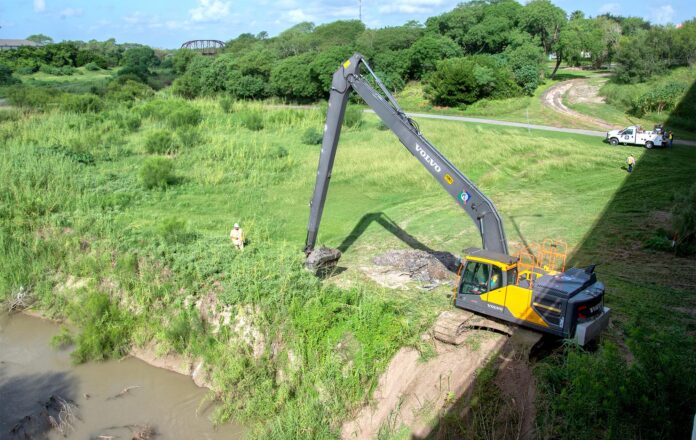
HARLINGEN — International Boundary and Water Commission engineers say the vegetation removal along a 6.3-mile stretch of the Arroyo Colorado from the U.S. Business 77 bridge in Harlingen to Cemetery Road is about 51 percent complete.
But Joel Saldivar also offered words of caution that the fast-growing vegetation in the flood plain may require tighter management in the future.
The $1.2 million, flood-control vegetation project aims to clear a path for water to drain more efficiently out of the City of Harlingen.
The arroyo is supposed to be able to move 21,000 cubic feet per second out of Harlingen, but due to siltation and obstructions — much of it overgrown vegetation — along its banks, its current capacity is nowhere near that mark.
Saldivar, a civil engineering technician with IBWC, said in a webinar last week the IBWC was granted a right-of-way to the arroyo in 1935 and assumed control of the floodway.
In 2016, a final vegetation management plan was authorized, and he said workers are adhering to its outline as they remove invasive species and, in some cases, re-plant native vegetation.
After Hurricane Alex in 2010, when floodwaters ran through the city, he said officials noted the flow rate could make only 27 percent of its maximum flow, or around 5,700 cfs.
“We started moving the trash that had been dumped into the arroyo. We had refrigerators, washers, dryers, car parts, tires — folks, hundreds of tires,” Saldivar said.
He also noted the flow of the arroyo was being severely restricted by overgrown vegetation.
The current project, which began a few months ago, involves clearing a strip between 50 and 100 feet to let the arroyo breathe when it comes to flood runoff. A wildlife corridor of vegetation, primarily consisting of native species, will be left to allow animal species to travel up and down the arroyo.
“The overgrown vegetation in the Arroyo Colorado is tremendous,” Saldivar said.
Some of the worst invasive species in the arroyo are giant cane, such as phragmites, popinac shrubs or trees and baccharis neglecta, also known as Rooseveltweed.
“It was introduced to America in the 1930s during the Dust Bowl era by the Roosevelt administration, and the task was to stop some of the wind erosion that was scouring the Plains. And this was a plant that was introduced for that purpose,” Saldivar said. “It fulfilled its mission, planted by the Conservation Corps.”
“But it got out of hand and it’s a prolific plant,” he added. “It is easy to control but it has a tremendous seed source… it’s known to bloom three times in a year so every time it blooms it throws a tremendous amount of seed.”
Phragmites is just one species of large, invasive cane in the arroyo drainage.
“We have several types of reed canes in the Arroyo Colorado,” he said. “The most common is the phragmites. There are some isolated pockets of carrizo cane and basically that’s taken to a site, hauled off to a mulching site, or taken to a landfill. The invasive species are cut at ground level and they are treated with an aquatic herbicide.”
Work crews are also finding some native plant species in the area, and Saldivar said every effort is made to save those.
Vasey’s adelia, also known as wild lime, is one of them.
“It is partial to shade or full sunlight, and for butterfly species, it is a host for the Mexican blue-winged butterfly,” he said. “Once the adelia has been identified, it will be protected in place.”
Mature trees such as ash species, hackberries and mesquite will be left in place, too, he said. Even some native sabal palms were discovered and will be saved.
Saldivar said care is taken not to disturb wildlife that makes the arroyo habitat its home.
“A buffer has been placed around the bird nests, and it is monitored until the birds have fledged and left,” he said.
He said box tortoises, protected species all, have been found in the work area, and noted wildlife cameras placed in the arroyo have picked up “a lot of bobcats.”
“One of the stakeholders did see a mountain lion,” he noted, referring to one of the landowners along the arroyo.
One of the concerns of those landowners along the arroyo is whether the vegetation removal will accelerate erosion, perhaps putting property at the top of the slope at risk.
“According to the 2016 vegetation management plan, we should not have that,” Saldivar said. “In the areas that are of concern, no vegetation will be removed on the steep slope of the arroyo.”
Saldivar said future vegetation clearing will be made easier thanks to some investment on the part of IBWC.
“The IBWC has bought a mulcher that is real light-weight-bearing equipment,” he said. “That’s what’s going to be introduced into the flood plain in these areas.”
Saldivar said the vegetation clearing in Phase II should be completed by spring or summer of 2022. A dredging phase of the same section of the arroyo should begin this year, bringing the total cost of the project to just over $6 million, according to city officials.



